Ferns are beautiful flowerless plants with a great aesthetic value, shape, and size. They not only give a happy feeling to the indoor environment it is but also acts as an air purifier thus adds a cool fresh and rejuvenating feeling to the indoor environment. The following article is all about types of ferns.
Ferns are very primitive plants, they originate before flower-bearing and non-flower-bearing plants. All the angiosperms (dicots and monocots) are flower-bearing plants. All the pine, cones, junipers or plants which grows in cold temperature are gymnosperms. Ferns are mostly herbs in their nature, very few are shrubs or small trees.
Although it looks difficult to maintain and grow ferns because of their delicate look but in actual growing fern is quite easy. All you need is moist soil and shade for the propagation of fern.
9 amazing different types of ferns are as follows
Ferns are so beautiful and are low in maintenance also. There are different types of ferns and all they need is good humidity therefore proper watering is required. Following are the details of different types of ferns, how to maintain them, and their propagation.
1. Boston fern

Scientifically known as Nephrolepis exaltata. These are easy growing 5 to 4 feet long ferns. Required partial sunlight and high humidity. Propagation is very easy just remove few leaves of the fern along with roots. Plant it in another pot the place it in the shade and water frequently. Within a week and a half new offshoots will come out from the bottom. Boston fern is also helpful in removing toxic substance from the indoor air, therefore, acts as an air-purifying fern plant.
2. Maidenhair fern

Scientifically known as Adiantum, another common name is walking fern it is also a type of fern. The plant requires a moist environment with low light and shade. Constant watering at least 4 times a week is necessary. Porous soil with 50% peat is great for growth. Keep the pot of fern on pebbles with water inside it makes the plant green and protects it from drying off. Propagation is via planting a small cut portion of the parent plant with root. Immediate watering is important. Cover the top surface with mulch to maintain the humidity.
3. Crocodile fern
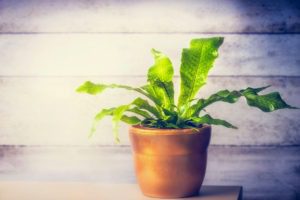
The botanical name is Microsorum musifolium. The name crocodile fern is because the front of this fern looks like the stakes of the crocodile. It is an excellent indoor plant. Maintenance and propagation are easy. Needs moist loamy soil with one hole so that the water can retain. It also needs a good composition in order to maintain the humidity of the surface. Water should be done whenever the surface gets dried. Propagation is through spores and roots with mature plant parts.
4. Rabbit foot fern
Rabbit foot fern is a type of fern scientifically known as Davallia fejeensis. This fern has a unique beautiful rhizome that looks like the foot of a rabbit. It is a beautiful indoor window plant that requires indirect sunlight. Watering is according to the moistness of the surface and spraying is best for the proper maintenance of this plant. Porous soil with peat moss is the best surface for this plant. Propagation is mainly by rhizomes with one or two mature leaves. Pin the rhizomes with leaves on the soil and water them properly.
5. Bird’s nest fern
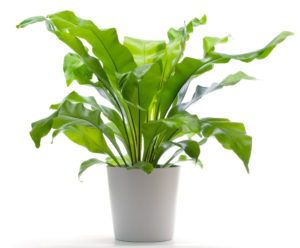
Botanically known as Asplenium nidus is an endangered ornamental fern. The fern is best known for its long fronds which give a good green soothing look to the indoor environment. This fern needs good humidity, proper watering, and a wet surface with porous and humus-rich soil. Watering should be done with care so that the rosette strustiter not get wet as it results in rotting. The fern needs indirect sunlight.
6. Asparagus fern

Scientifically known as Asparagus aethiopicus other common name is Foxtail fern is a beautiful indoor ornamental plant although not a true fern. This plant can survive all seasons and growth is best during the spring. Propagation of this plant is mainly through seeds. Another method of propagation is via stem cuttings with roots attached to it. Well-irrigated soil is required, regular watering is not so necessary. Avoid direct sunlight and keep it away from children as the seeds are poisonous.
7. Japanese painted fern
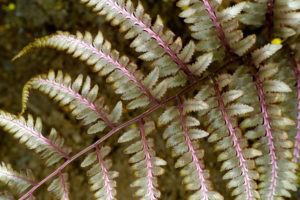
The botanical name of Japanese painted fern is Athyrium niponicum other common name is oriental lady fern. This fern is the most low maintenance fern. This fern can tolerate moderate drought conditions, therefore, regular watering is not necessary. The leaves of these ferns are very beautiful and colorful and give a vibrant sense to the environment. The soil should be well-drained and rich in humus.
8. Lemon button fern
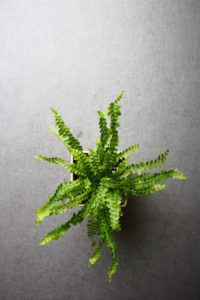
Lemon button fern or Nephrolepis cordifolia are small sweet and beautiful ferns. These ferns are easy to handle and can grow in cute little pots or hanging baskets and we can place them anywhere on our study table, or windows or shelves. This plant requires indirect light and moist soil. Propagation is simple via mature leaves with roots. Plant them in moist humus-rich soil and water them regularly.
9. Staghorn fern
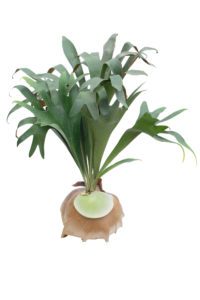
Staghorn fern or Platycerium species are the ferns whose fronds look like horns of a stag. These are epiphytic ferns that are the rows on tree trunks therefore for the indoor propagation of these ferns the soils should be rich with humus, or peat moss, or other organic matters. These ferns are very unique in their looks thus adds up an out of the world feeling to the house.
These ferns require medium light, frequent watering, and fertilize each month mixed in water.
